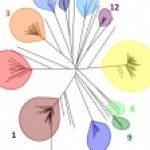Lien vers Pubmed [PMID] – 18653318
Res. Microbiol. 2008 Jul-Aug;159(6):436-40
Multilocus sequencing strain types of a panel of 43 Candida albicans isolates from animals, including mammals and avian species, were compared with strain types for human isolates. The clade distribution of the animal isolates was significantly different from that of the human isolates, in both a comparison involving a total of 1580 isolates from multiple geographical sources and a comparison restricted to 675 human isolates from the same geographical regions as the animal isolates. A nearest-neighbour analysis involving the 43 animal isolates and 67 human isolates, randomly selected to give a proportionate distribution of geographical sources, showed a strong statistical trend towards genetic selection of different C. albicans strain types adapted to non-human animal hosts, but without complete genetic separation.



